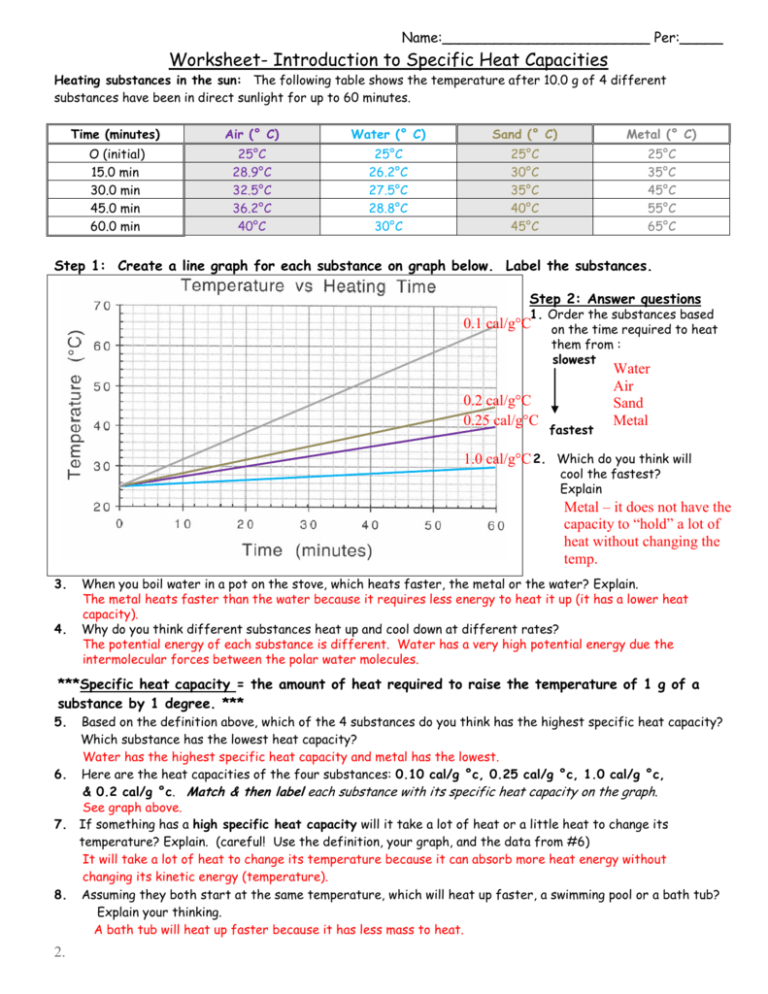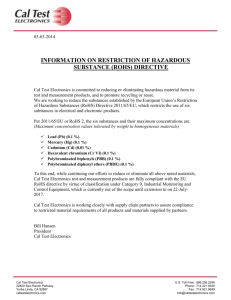Worksheet- Introduction to Specific Heat Capacities
advertisement

Name:________________________ Per:_____ Worksheet- Introduction to Specific Heat Capacities Heating substances in the sun: The following table shows the temperature after 10.0 g of 4 different substances have been in direct sunlight for up to 60 minutes. Time (minutes) Air (° C) Water (° C) Sand (° C) Metal (° C) O (initial) 15.0 min 30.0 min 45.0 min 60.0 min 25°C 28.9°C 32.5°C 36.2°C 40°C 25°C 26.2°C 27.5°C 28.8°C 30°C 25°C 30°C 35°C 40°C 45°C 25°C 35°C 45°C 55°C 65°C Step 1: Create a line graph for each substance on graph below. Label the substances. Step 2: Answer questions 1. Order the substances based on the time required to heat them from : slowest 0.1 cal/g°C 0.2 cal/g°C 0.25 cal/g°C fastest Water Air Sand Metal 1.0 cal/g°C 2. Which do you think will cool the fastest? Explain Metal – it does not have the capacity to “hold” a lot of heat without changing the temp. 3. 4. When you boil water in a pot on the stove, which heats faster, the metal or the water? Explain. The metal heats faster than the water because it requires less energy to heat it up (it has a lower heat capacity). Why do you think different substances heat up and cool down at different rates? The potential energy of each substance is different. Water has a very high potential energy due the intermolecular forces between the polar water molecules. ***Specific heat capacity = the amount of heat required to raise the temperature of 1 g of a substance by 1 degree. *** 5. Based on the definition above, which of the 4 substances do you think has the highest specific heat capacity? Which substance has the lowest heat capacity? Water has the highest specific heat capacity and metal has the lowest. 6. Here are the heat capacities of the four substances: 0.10 cal/g °c, 0.25 cal/g °c, 1.0 cal/g °c, & 0.2 cal/g °c. Match & then label each substance with its specific heat capacity on the graph. See graph above. 7. If something has a high specific heat capacity will it take a lot of heat or a little heat to change its temperature? Explain. (careful! Use the definition, your graph, and the data from #6) It will take a lot of heat to change its temperature because it can absorb more heat energy without changing its kinetic energy (temperature). 8. Assuming they both start at the same temperature, which will heat up faster, a swimming pool or a bath tub? Explain your thinking. A bath tub will heat up faster because it has less mass to heat. 2.








